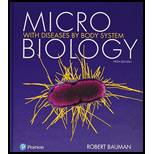
Microbiology with Diseases by Body System (5th Edition)
5th Edition
ISBN: 9780134477206
Author: Robert W. Bauman Ph.D.
Publisher: PEARSON
expand_more
expand_more
format_list_bulleted
Concept explainers
Question
Chapter 14, Problem 8TMW
Summary Introduction
To tell:
Why all iatrogenic infections are healthcare-associated, but not all healthcare-associated infections are iatrogenic.
Introduction:
Iatrogenic infections are caused due to the hospital and are healthcare-associated. Infectious disease which spread through hospital agents, bandages, and hospital healthcare workers are likely to be iatrogenic infections.
Expert Solution & Answer
Want to see the full answer?
Check out a sample textbook solution
Students have asked these similar questions
What is the structure and function of Eukaryotic cells, including their organelles? How are Eukaryotic cells different than Prokaryotic cells, in terms of evolution which form of the cell might have came first? How do Eukaryotic cells become malignant (cancerous)?
What are the roles of DNA and proteins inside of the cell? What are the building blocks or molecular components of the DNA and proteins? How are proteins produced within the cell? What connection is there between DNA, proteins, and the cell cycle? What is the relationship between DNA, proteins, and Cancer?
Why cells go through various types of cell division and how eukaryotic cells control cell growth through the cell cycle control system?
Chapter 14 Solutions
Microbiology with Diseases by Body System (5th Edition)
Ch. 14 - Prob. 1TMWCh. 14 - A Deadly Carrier In 1937, a man employed to lay...Ch. 14 - Prob. 2TMWCh. 14 - Prob. 3TMWCh. 14 - Why is mutated Streptococcus pneumoniae, which...Ch. 14 - Prob. 5TMWCh. 14 - Prob. 6TMWCh. 14 - TB in the Nursery In the early fall, a neonatal...Ch. 14 - Why is an acute disease with a high rate of...Ch. 14 - Prob. 1EDCS
Ch. 14 - Prob. 8TMWCh. 14 - Prob. 1MCCh. 14 - Prob. 2MCCh. 14 - Prob. 3MCCh. 14 - The most frequent portal of entry for pathogens is...Ch. 14 - Prob. 5MCCh. 14 - Prob. 6MCCh. 14 - Prob. 7MCCh. 14 - Prob. 8MCCh. 14 - Prob. 9MCCh. 14 - Prob. 10MCCh. 14 - Which of the following statements is the best...Ch. 14 - Prob. 12MCCh. 14 - Prob. 13MCCh. 14 - Prob. 14MCCh. 14 - Prob. 15MCCh. 14 - Prob. 1FIBCh. 14 - Fill in the Blanks 2. Infections that may go...Ch. 14 - Prob. 3FIBCh. 14 - Prob. 4FIBCh. 14 - Prob. 5FIBCh. 14 - Prob. 6FIBCh. 14 - Prob. 7FIBCh. 14 - Prob. 8FIBCh. 14 - Prob. 9FIBCh. 14 - Prob. 10FIBCh. 14 - Prob. 1SACh. 14 - Prob. 2SACh. 14 - Prob. 3SACh. 14 - List Kochs four postulates, and describe...Ch. 14 - Prob. 5SACh. 14 - Prob. 6SACh. 14 - Describe the parenteral route of infection.Ch. 14 - In general, contrast transient microbiota with...Ch. 14 - Contrast the terms infection and morbidity.Ch. 14 - Prob. 10SACh. 14 - Each map below shows the locations (dots) of cases...Ch. 14 - Prob. 2VICh. 14 - Explain why Ellen H., a menopausal woman, may have...Ch. 14 - Prob. 2CTCh. 14 - A 27-year-old woman went to her doctors office...Ch. 14 - Over 30 children younger than three years of age...Ch. 14 - Prob. 5CTCh. 14 - Corals are colonial marine animals that feed by...Ch. 14 - If a mutation occurred in Escherichia coli that...Ch. 14 - Using the following terms, fill in the following...
Knowledge Booster
Learn more about
Need a deep-dive on the concept behind this application? Look no further. Learn more about this topic, biology and related others by exploring similar questions and additional content below.Similar questions
- In one paragraph show how atoms and they're structure are related to the structure of dna and proteins. Talk about what atoms are. what they're made of, why chemical bonding is important to DNA?arrow_forwardWhat are the structure and properties of atoms and chemical bonds (especially how they relate to DNA and proteins).arrow_forwardThe Sentinel Cell: Nature’s Answer to Cancer?arrow_forward
- Molecular Biology Question You are working to characterize a novel protein in mice. Analysis shows that high levels of the primary transcript that codes for this protein are found in tissue from the brain, muscle, liver, and pancreas. However, an antibody that recognizes the C-terminal portion of the protein indicates that the protein is present in brain, muscle, and liver, but not in the pancreas. What is the most likely explanation for this result?arrow_forwardMolecular Biology Explain/discuss how “slow stop” and “quick/fast stop” mutants wereused to identify different protein involved in DNA replication in E. coli.arrow_forwardMolecular Biology Question A gene that codes for a protein was removed from a eukaryotic cell and inserted into a prokaryotic cell. Although the gene was successfully transcribed and translated, it produced a different protein than it produced in the eukaryotic cell. What is the most likely explanation?arrow_forward
- Molecular Biology LIST three characteristics of origins of replicationarrow_forwardMolecular Biology Question Please help. Thank you For E coli DNA polymerase III, give the structure and function of the b-clamp sub-complex. Describe how the structure of this sub-complex is important for it’s function.arrow_forwardMolecular Biology LIST three characteristics of DNA Polymerasesarrow_forward
arrow_back_ios
SEE MORE QUESTIONS
arrow_forward_ios
Recommended textbooks for you
- Case Studies In Health Information ManagementBiologyISBN:9781337676908Author:SCHNERINGPublisher:Cengage
 Comprehensive Medical Assisting: Administrative a...NursingISBN:9781305964792Author:Wilburta Q. Lindh, Carol D. Tamparo, Barbara M. Dahl, Julie Morris, Cindy CorreaPublisher:Cengage Learning
Comprehensive Medical Assisting: Administrative a...NursingISBN:9781305964792Author:Wilburta Q. Lindh, Carol D. Tamparo, Barbara M. Dahl, Julie Morris, Cindy CorreaPublisher:Cengage Learning Human Heredity: Principles and Issues (MindTap Co...BiologyISBN:9781305251052Author:Michael CummingsPublisher:Cengage Learning
Human Heredity: Principles and Issues (MindTap Co...BiologyISBN:9781305251052Author:Michael CummingsPublisher:Cengage Learning

Case Studies In Health Information Management
Biology
ISBN:9781337676908
Author:SCHNERING
Publisher:Cengage



Comprehensive Medical Assisting: Administrative a...
Nursing
ISBN:9781305964792
Author:Wilburta Q. Lindh, Carol D. Tamparo, Barbara M. Dahl, Julie Morris, Cindy Correa
Publisher:Cengage Learning


Human Heredity: Principles and Issues (MindTap Co...
Biology
ISBN:9781305251052
Author:Michael Cummings
Publisher:Cengage Learning